Deep sea salvage pioneer, John Kingsford, lives a stone’s throw from Gard’s head office. His company, Deep Ocean Search set the world record for undersea salvage at 5,150 m, rescuing part of a wartime silver cargo worth USD 50 million.

Pioneering cargo salvage at record depth recovered tons of wartime silver
Published 10 June 2015
Background
The wreck of the SS CITY OF CAIRO (CAIRO) lay undiscovered on the South Atlantic seabed for more than 70 years. This passenger and general cargo ship had been requisitioned by the British government during World War II. The CAIRO was on her way to Recife, Brazil, a leg of a voyage from Bombay to the UK, when, on 6 November 1942, some 772 km south of St Helena in the South Atlantic, the ship was torpedoed by a German submarine. On board were 302 passengers and crew, of whom 104 sadly lost their lives, mainly in lifeboats awaiting rescue. There was also cargo aboard - pig iron, timber and wool, plus a secret consignment of 122 tons of silver rupees in 2,182 wooden boxes. The silver had been called in by the British Treasury to support the war effort, but ended up over 5,000 m under the sea.
The ship and cargo were presumed lost but when Kingsford found the cargo details in 1984, he had an idea to find it one day. However, it would be almost 30 years before he led this extraordinary expedition to find the CAIRO. His company, Deep Ocean Search Ltd (DOS) is one of only a few companies providing a one-stop deep sea salvage service. DOS operates the survey vessel, JOHN LETHBRIDGE with a multi-skilled team using a unique combination of sonar and remotely operated underwater vehicle (ROV) equipment.
Research
The starting point for this type of salvage operation is always proof of loss and establishing ownership of the lost property. A team of three to four researchers gather information, a task which has been made much easier by advances in technology. Insurance archives are often a good starting point, although as insurance companies come and go, older records may no longer exist or have been lost. Public records are also an important source.
In the CAIRO project, secret government papers provided the proof that the ship had the silver on board. A secret despatch from Embarkation Bombay to the War Office confirms that the CAIRO sailed from Bombay on 5 October 1942 with 2,182 boxes of silver bullion weighing 122 tons on board.
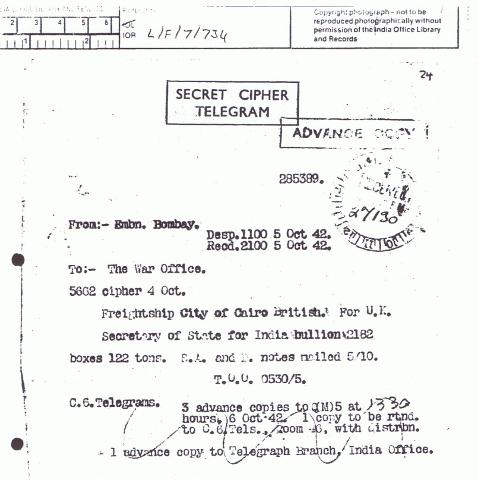
Cipher telegram
Secret telegram to the War Office confirms the CAIRO sailed with 2,182 boxes of bullion on board
The next step was to establish where on the ship the cargo had been stowed. This information was provided by the eye witness account of the ship’s surgeon, Dr Douglas Quantrill. As he was helping others after the torpedo hit, he saw the hatch covers of hold number four had been blown off, exposing open boxes of silver coins.
Next came the investigation into the actual incident. Over the years, key documents have become publicly available. This enabled the DOS researchers to dig into e.g. the military orders on both sides; the log books of both the CAIRO and the submarine, as well as eye witness accounts. Piece by piece the facts were collected to form a detailed understanding of the incident and the likely location of the wreck.
An in depth overview of the ship was compiled identifying characteristics unique to the ship. This was done using the ship’s plans, photographs and descriptions. Identification was critical as no name or bell were found on the wreck, so the CAIRO was identified by reference to its porthole formation.

Shipwreck
The formation of the CAIRO’s portholes enabled a positive identification to be made
The last research step involved evaluating the likely wreck site - its depth, topology etc. - to ensure that a salvage operation was viable. The CAIRO’s location was remote – some 1,000 NM off West Africa. The weather, swell and currents were all challenging factors. The wreck was located at an extreme depth in the foothills of the mid-Atlantic ridge.
An operation of this nature at 5,000 m had never been done before. Nevertheless, having carefully evaluated all the information, Kingsford decided to make an attempt and signed a contract with the British Government.
Deep sea search
The first step was to pinpoint as accurately as possible the actual location of the wreck using the navigational information resulting from the research. This was followed by an environmental study of the location’s seabed and currents and an evaluation of logistics - safety and security of personnel etc.
Next the survey vessel was despatched to the location and the search operation got underway. A typical search box is an oblong of about 1,500 NM2. DOS used a combination of sonar and satellite positioning to survey the sea bed. The search started along the centre line of the box and proceeded to and fro as if “mowing a lawn”. This process was slow and cumbersome, involving some 11,000 meters of sonar cable at extreme depths. While the sea bed was being swept, the survey team of French oceanographers were monitoring their screens in the control room. Two following the sonar in real time, another was reviewing the recorded images and the fourth navigating.
The seabed was broken up by lots of rocks and canyons and it was not known whether the wreck would be in one piece or even visible at all on the seabed. This combination made it difficult to judge whether a sonar shadow was a natural feature of the seabed or an object.
After about three weeks, Kingsford received an excited call about a possible find - he admits he was not convinced that it was the CAIRO as it did not correspond to expectations. Nevertheless, he trusted his team’s view that the seabed looked disturbed and decided to take a closer look using the JOHN LETHBRIDGE’s ROV.
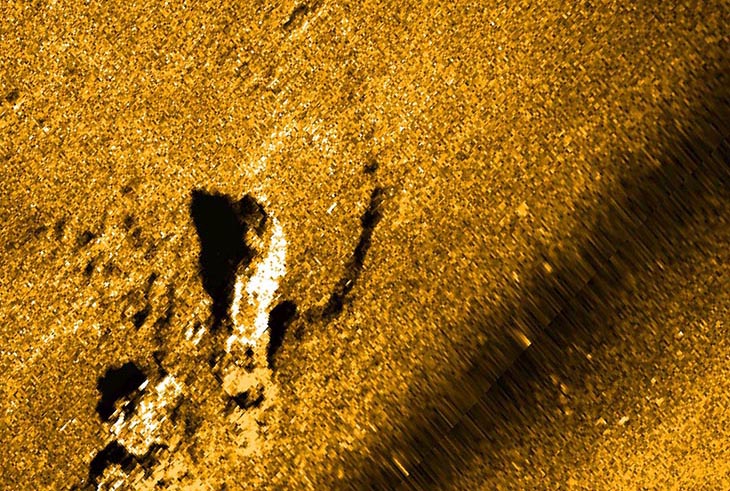
Sonar image
The sonar image showing the CAIRO in two parts with its impact craters on the bottom of the South Atlantic
After some hours, the ROV relayed pictures from the pitch dark sea bed of impact craters and a ship broken in two. Parts of the ship were covered in several meters of mud. In the absence of a name, builder’s plaque, bell or ship’s porcelain, it took six frustrating hours to make a positive identification comparing images of the wreck with photographs and drawings. Astonishingly, hold number four and its secret treasure were clearly visible, revealing silver rupees stamped with the British Crown.
Deep sea recovery
Although the ROV was designed to work at 6,000 meters, the combination of pressure (500 bars), temperature, trapped gas and repeated dives led to multiple breakdowns of various systems. Kingsford’s team was lucky if they got 2 hours a day on the seabed. After a lot of trial and error over several months, DOS’s team eventually managed to solve all the issues.
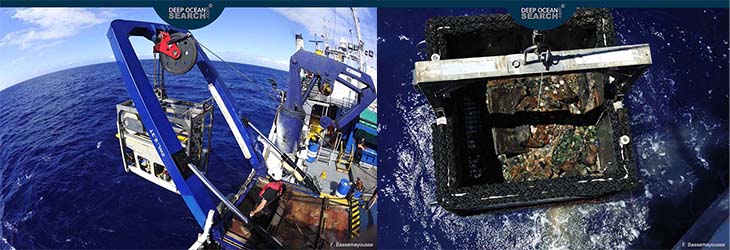
ROV ready to dive in
The ROV ready to dive and the secret treasure trove raised to the surface in a pioneering salvage operation
Kingsford cannot reveal how many of the 122 tons of silver coins were recovered, however the operation took eight months.
The logistics involved reveal the challenges DOS faced. The ship spent three weeks at a time at the remote deep sea salvage point. It took three days steaming to get to port; two days in port for crew change and stores and provisions, then three days back to the wreck site.
The salvage operation was completed in September 2013. The coins were handed over to the British authorities and have since been melted down. Only in 2015 did the authorities give permission to announce the find, which has allowed DOS to share this remarkable story.
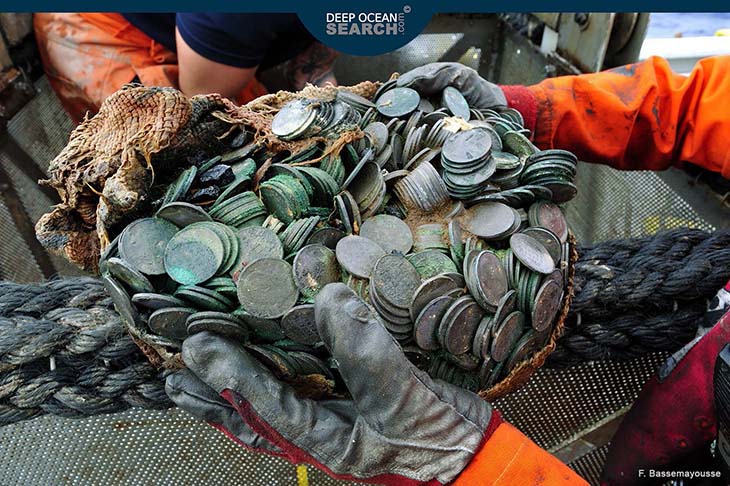
Some of the millions of silver rupees
Some of the millions of silver rupees recovered from a record depth of 5,105 m
Final comments
Historic shipwreck expert, Taylor Zajonc believes the project was ground breaking and may usher in a new era in deep sea operations. Kingsford says: “What we did was not a catalyst, it’s happening anyway. The technology has improved and there is also a desire to explore at extreme depths”.
He suggests there will be more deep sea exploration to serve the sub-sea mining and oil and gas industries, not to mention the biological science sector, on the look-out for new compounds for new medicines.
Kingsford estimates that there are many thousands of ship wrecks around the world. His view is that location of wrecks and cargo recovery benefit multiple parties and would like to see more information exchange with marine insurers. In addition, it should be possible to find and recover dangerous and harmful cargo lost at extreme depths to protect the environment.
John Kingsford reflects that in this 70th year since the second world war ended, it is fitting to note and remember the significant contribution to the war effort made by the world’s merchant shipping fleet. On leaving the wreck of the CAIRO, as a mark of respect, DOS left a plaque in honour of those who lost their lives.
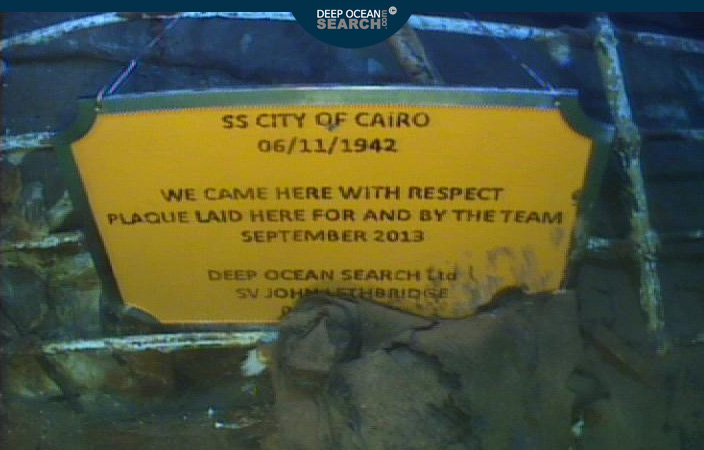
A fitting memorial left on the wreck following an emotive salvage
A fitting memorial left on the wreck following an emotive salvage
Questions or comments concerning this Gard Insight article can be e-mailed to the Gard Editorial Team.
John Kingsford, CEO,Deep Ocean Search
Our thanks to John Kingsford for his assistance in preparing this Insight and for his permission to use the photographs taken by DOS during the CAIRO project. Further information and photographs can be found at www.deepoceansearch.com.
Deep Ocean Search Ltd is a multi-task and survey recovery company providing ultra-deep water services up to 6,000 meters to the offshore, insurance, scientific, cable and aviation industries.
The story of the CAIRO has been written by Ralph Barker in his book, “Goodnight, sorry for sinking you”. ISBN 0-00-216464-7


